The Rushlight Club - 75th Anniversary Meeting, October 2007, Sturbridge, MA
By Alex Marrack, Chairman, Historic Lighting Club (of Great Britain)
Originally printed in the HLC publication Midnight Oil, No 63 Winter 2007
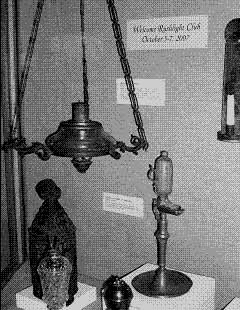
As most HLC members will be aware, the Rushlight Club is the great grand-daddy of all the lighting clubs. Founded in 1932 and originally based in the New England area of the USA, the Rushlight Club is in fact the oldest 'collectors club' of any type anywhere in the world. The 75th Anniversary meeting promised to be a once in a lifetime event so I decided to make the pilgrimage to be there.
The Meeting was held in Sturbridge, Massachusetts where the events were divided between the Old Sturbridge Village (OSV) and the Sturbridge Host Hotel across the highway. The Old Sturbridge Village is itself worthy of mention, a living museum designed to portray life in New England in the period 1790s to 1840s and featuring 40 plus original buildings moved to the site. (www.osv.org). The OSV was founded by Albert B. Wells and J. Cheyney Wells, who began collecting early New England artifacts, tools and records after a conversation with Rushlight member Malcolm Watkins. The village opened to the public on June 8th, 1946 and has historic ties with the Rushlight Club as the Wells were also early members.
Saturday October 6th was a fine New England fall day. The morning was spent at Old Sturbridge Village where the first showcase when we entered the museum was a display of selected lighting artifacts and a notice proclaiming: "Welcome Rushlight Club". Rushlighters toured the site at their leisure, kicking up the crisp leaves on the paths between the painted wooden buildings. Live demonstrations included dyeing wool outside, over an open wood fire, the candle making factory and a fully operational tinsmith's shop. Here small tinplate whale-oil lamps were being made, hand soldered with the soldering-irons toasting over a charcoal stove. Quote of the day goes to the tinsmith "Pewter lamps pooh!, bring them to me and I'll use 'em for solder, then you can have fine new tinplate". Something tells me that not everyone would agree...
Highlight of the day for most was the display of early lighting, which fills a whole building. As Old Sturbridge Village documents an age before Kerosene, there were no kerosene (paraffin for the Brits) lamps to be seen. With the exception of Moderator lamps and a Carcel, most of the other lamps are types not encountered often in the UK. Rushlighters also had the option to see behind the scenes with a tour of the reserve collections (excluding lighting).
In the evening it was back to OSV for a reception at the Oliver Wight Tavern where various members had items for sale and a silent auction was held. (For HLC members more used to the non-silent version, a silent auction involves buyers writing down their bid on a card attached to the lot, the highest bid at 10.00 pm bought the item).
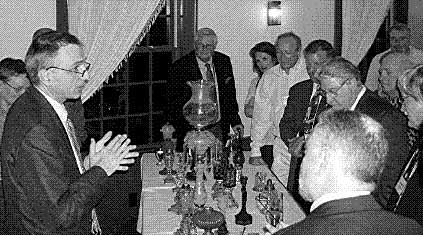
At 6pm the Banquet began. Attended by over 80 members the hall was full. After the meal there was a short 'business' meeting (something akin to the HLC AGM). As is customary the meeting was opened by the ceremonial lighting of the Rushlight, an honour usually given to someone who has particularly furthered the cause of the club. In this case President Peter Gregory invited three members, David Lauer, M.J Howell and Dan Mattausch, to light the rush in recognition of their work in producing the Rushlight Archives DVD. As the Board of officers had met the previous day, business was kept short, although quite controversial at times.
Having concluded the business, it was announced that the Rushlight DVD was available and ready for purchase. This 'magnum opus', edited by HLC member Dan Mattausch, contains all of the information ever published in The Rushlight journal up to December 2006 and on only one data-DVD! Complete with an interactive search guide and instructions for use. (Copies will be available to the HLC subject to interest). Marianne Nolan (Rushlight Editor) then presented members with a copy of the Rushlight Cumulative Index (paper) 1980 to 2006. Needless to say, by the end of the meeting all fifty of the 75th anniversary special edition copies of the DVD were sold out!
In recognition of the event, everyone attending the banquet received a brushed tinplate candle holder, stamped with the Rushlight logo. These were specially made for the Rushlight club by member Mr. Garrett Turrall from Michigan.
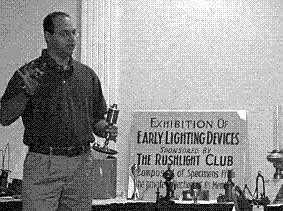
The evening was concluded by a talk and slideshow given by Mr. Kirk Nelson, Director of the New Bedford Museum of Glass. The subject was Sandwich Glass lighting (ie glassware made by the Boston and Sandwich glass company) and in addition to the slides there was a substantial display of glass lamps and other artifacts. The glass industry was once very important in New England and early in the 1820s the art of glass pressing was perfected, allowing efficient production of decorative glassware including lamps. We were shown how moulds were often re-used, so that a mould to make table glass might be used to make a lamp fount, a practice that enables unidentified lamps to be compared with catalogues and known examples to determine the true maker. Again, most examples were from the pre-kerosene era, though there was at least one superb opal cut to ruby Sandwich glass kerosene lamp.
Sunday, October 7th began with an early group breakfast (for those who got out of bed in time) followed by a talk on "Pewter Lighting of Massachusetts, 1820 to 1860" given by David Kilroy, President of the Pewter Collectors' Club of America. Again the use and reuse of expensive moulds (used in this case to cast pewter) allowed comparison of unknown lamps with known items, e.g. goblet bowls as an aid to identification. All the lamps shown were in a highly polished state, which David pointed out was undoubtedly the way they were made, and most appropriate for lighting equipment. The lamps certainly looked better without patina (dirt)!
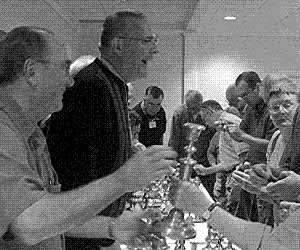
The talk was followed by reminiscences of collectors and presidents of the past, presented by Charles (Chuck) Leib. This was followed by a 'show and tell' session where quite a few members brought items originally from the collections of early Rushlighters. One particular item that caught my eye was a poster from 1935, presented by Dan Mattausch, which appeared at the first ever exhibition staged by the Rushlight Club in Boston. Dan had acquired it by way of eBay having recognized it from a photograph in an early Rushlight Journal. A case of the Club becoming history rather than just researching it!
Sunday afternoon members visited OSV once more, again blessed by fine autumnal weather, and were able to see those buildings they had missed earlier. However, the primary reason for our presence was to view the reserve lighting collection housed in the basement of the lighting collection building itself. There was much to be gained on both sides, for amongst the visitors there were many genuine experts, and several unknown artifacts were positively identified.
In the evening M.J. Howell presented an optional 'get to grips with your DVD' session, and with the aid of a computer was able to demonstrate how users should configure their Windows and Adobe security settings so that the DVD functions without annoying security pop-up messages. Fortunately for those who did not attend, there is a set of written instructions included with every DVD!
After the computer was switched off, those remaining indulged in some real fun as Joel Paradis (J.P. Tinsmith) had brought in an original vapour burner from Hyde Hall in Cooperstown, New York. The burner is one of a set of 12 that were fitted as an upgrade to three Argand whale oil chandeliers in 1833. The vapour burner used a mixture of alcohol and distilled turpentine, AKA Burning Fluid. And burn it did! giving a superb bright light. HLC members might be surprised to learn that this was one of the few lamps I saw actually lit. However the dearth of lit lamps could be partly explained by the distances many members have to travel as burners, lamps, and flammable liquids do not go well with air travel and security restrictions.
A feature of most Rushlight Meetings is that a local member will present 'Open House', allowing those attending the meeting to see their collection. In this case 'Open House' was the home of Joseph and Kathy Arvay on Nantucket Island. Those members traveling to Nantucket spent Monday getting there, by way of Haverhill, Massachusetts. The detour was to visit the reserve collections of Historic New England.
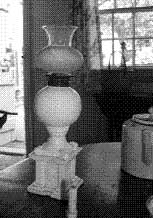
Once again the weather was good and Tuesday 9th October was fine. In the morning members were treated to a visit 'behind the scenes' to the reserve collection of the Nantucket Whaling Museum www.nha.org. Once again there were surprises in store as visitors were able to identify special items. In particular our local mentor, Joe Arvay, discovered a selection of wick-picks including some superb examples he'd not seen before. Always nice to make a surprise find on your home turf ! Probably the most memorable item was a 45 gallon barrel of real Sperm-whale 'head matter'. This was recovered (legally) from the carcass of a sperm whale washed ashore on New Year's Day 1998. The 'oil' had a texture like fatty gravy though it was perfectly clear, and a smell (not unpleasant) reminiscent of cod-liver oil mixed with old fashioned metal primer paint. One member, Ed Klausmeyer (AKA "Spermaceti Eddy") was so overcome by meeting his namesake that those around thought he might dive into the barrel! Fortunately he restrained himself, although he and several other people were able to dip their fingers in the barrel!
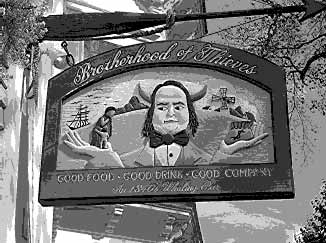
heart of old Nantucket town
The rest of the day was spent visiting Joe and Kathy's house in small groups, visiting the Whaling museum and sightseeing on the island. The Arvay's house is a typical Nantucket wooden fisherman's cottage dating from the late 1700s. It had recently benefited from being 'undermined' so that a basement was created, doubling the size of the house without altering any aspect. Both house and basement served as a splendid backdrop for the Arvay collection, featuring several Solar lamps, as well as whale oil lamps and other pre-kerosene lighting.
This concludes my report of the Rushlight 75th Anniversary Meeting. On the way back from Nantucket Island we visited the Sandwich Glass Museum www.sandwichglassmuseum.org, a small but superb museum which is full of paraffin lamps and well worth visiting!
My thanks to Dan and Nancy Mattausch for the accompanying photographs and their help in checking the above for mistakes!
The Rushlight Club Inc. www.rushlight.org